Sharovy crane 1 1 4 inches: device, advantages, features of
Modern ball valves confidently won a large part of the market from competing solutions and continue to gain popularity. What are they so good on the background of alternatives? How does a typical ball valve 1: 4 - 1 1: 4 inch size? Does the choice and installation of these cranes have any subtleties? Let's try to answer these questions.

How it works
The distant ancestor of the ball valve (cork valve) was a rotary all-metal valve with a slot in it, movably fixed in the metal case. The tightness of the shutter (by the way, far from absolute) was provided by fitting the plug to the body; the function of sealing rod performed, as a rule, stuffing box.
The original design had a number of serious flaws.
- The force required to rotate the rod was quite significant: the coefficient of friction of the metal on the metal is quite large.
Curiously, cork taps of a large size are equipped with a lubrication system, which partly solves this problem.
- The gland required periodic packing; what is curious - it was produced even with a simple valve.
- The cork taps had a rather high hydraulic resistance: the slot in the tube, narrow compared to the internal diameter of the pipe being connected, created a serious obstacle to the flow of the working medium.

Ball valve is a deep modernization of cork crane design.
- The shutter became spherical and got a perfectly smooth surface with the highest quality of processing.
- The hole in it has increased: now its size is equal to or close to the internal diameter of the pipe attached to the valve.
- The seal of the shutter is provided not by grinding in metal surfaces, but by ring saddles made of low-friction polymers - Teflon or Teflon.
- The rod is sealed with a ring of the same polymer or a pair of rings of heat-resistant rubber. The development of a seal designed for at least 500 to 1000 valve operation cycles is compensated for by tightening it with the help of a packing nut.
The only parameter that suffered during valve modernization is its operating temperature, which is now limited by the thermal resistance limit of polymer seals (150 - 250С). This is partly why cork valves, despite obvious obsolescence, are still produced and used on pipelines transporting high-temperature or corrosive media.
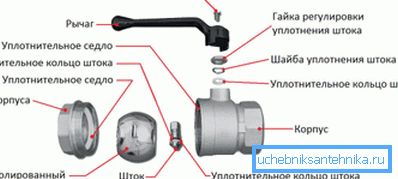
Benefits
What attracts a potential buyer ball valve - 1: 4 inches, 1: 2, 1 1: 4 and other sizes - against the background of traditional cork and screw valves?
- Low hydraulic resistance. It is approximately equal to the resistance of the pipe of the appropriate length.
- Compactness. All ball valve sizes 1 1: 4 inches are significantly smaller than those of a similar screw valve. It differs from the cork crane by at least a smaller installation height.
- Airtight shutter. The absolute majority of ball valves are classified as Class A according to GOST 9544-2005, which means that there are no leaks in the closed state.
It is curious: the valve, unlike throttling valves, has only two working positions - open and closed. However, the ball valve can still be used to adjust the head without any damage to its resource.
- Lack of accumulation of garbage under the valve seat, characteristic of screw valves.
- Arbitrary direction of water flow. Screw valves can be placed only in such a way that the water presses the valve from below - otherwise, if you try to open the valve, the valve may tear off.
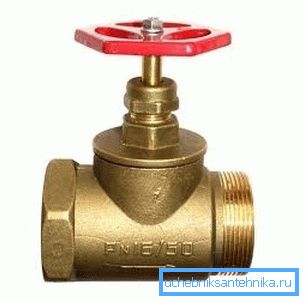
- Minimum opening effort, distinguishing ball valves from cork.
- Finally, the main thing: all ball valves are exceptionally fault tolerant and require virtually no maintenance.. As a maximum, after several years of active use, it may be necessary to tighten the seal around the stem.
The price of a ball valve, if different from competing products of the same size, is extremely insignificant.
As you can see, the popularity of the solution is quite explicable.
Practical advice
We allow ourselves to give the reader a number of tips that may be useful to him at different stages of communication with the type of valves that we are interested in.
Selection
On the valve body there are usually the manufacturer's logo, an indication of the size of the thread to be connected (DN on imported products and remote controls on domestic) and working pressure (PN and RU, respectively).
The working pressure in pipelines for cold and hot water supply in normal mode does not exceed 6–8 kgf / cm2; accordingly, valves with a declared working pressure of 16 and higher atmospheres (RU16, RU25, RU40) are excellent for any sanitary communications.
The nominal size can be specified both in millimeters (DU15) and in inches (DN 1/2 or just 1/2). In order to simplify the life of the reader, we present a table of sizes.
| Inches | Millimeters |
| 1/2 | 15 |
| 3/4 | 20 |
| one | 25 |
| 1 1/4 | thirty |
| 1 1/2 | 40 |
| 2 | 50 |
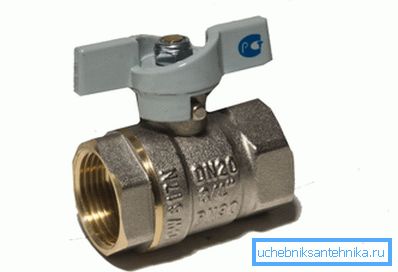
When choosing, you should pay close attention to two things:
- The stroke of the handle. It should turn with moderate effort and not jam in intermediate positions.
- Body material. Siluminous crafts from You-Know-What-Country are not always able to survive at least the installation; our choice is honest brass. The simplest instruction will help you to make the mistake: it is worth buying yellow gates, not silver ones, because anything can be hidden under chrome plating.
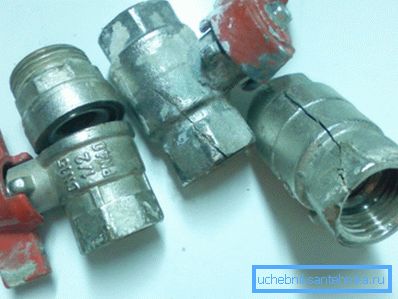
Installation
When you install the valve with your own hands a little bit.
- Avoid excessive effort.
- Use open-end wrench or adjustable wrench. Gas is easy to crush or deform the body.
- When wrapping the boom or nozzle in the installed valve, hold the valve body.
Service
As already mentioned, it comes down mainly to tightening the seal. When it is developed, the ring changes to the same. As a temporary solution, several turns of FUM tape can be wound under the gland-nut. (See also the article Hermetic for pipes: features.)
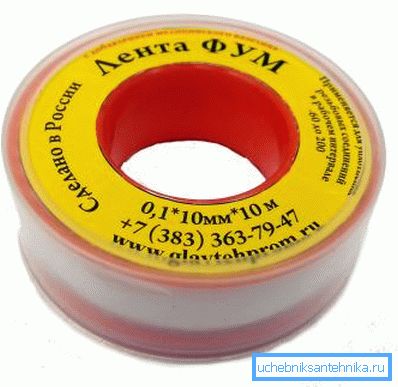
Conclusion
We hope that our material will help the reader in the selection and use of sanitary equipment. In the video in this article, as usual, you can find additional thematic information. Successes!